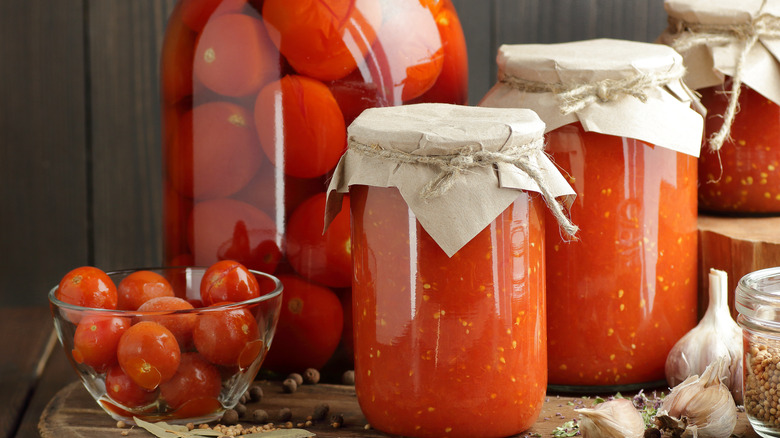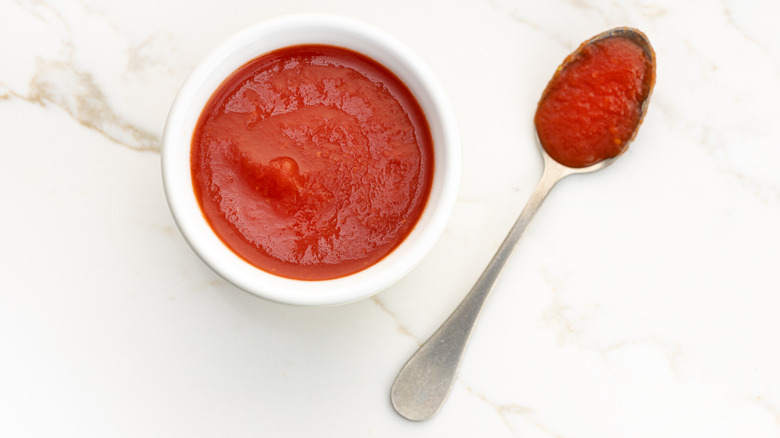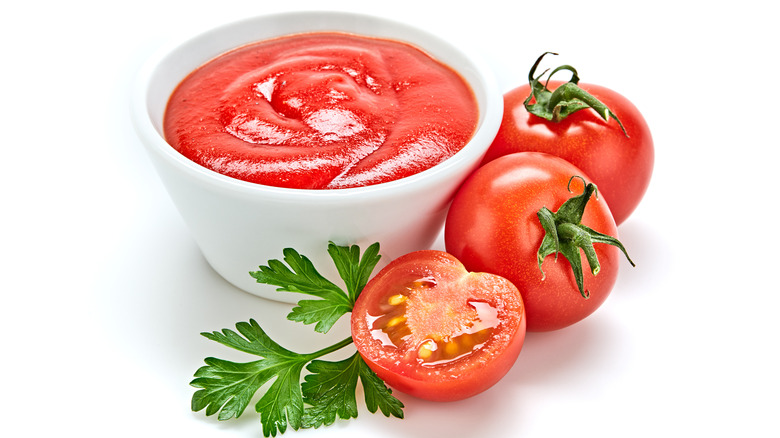What Makes Tomato Purée And Tomato Sauce Different
Tomato, tahmato. The grocery store canned aisle is a festival of tomato products. Tomato paste and purée are longtime headliners, but what's the difference between the two? We already know that tomatoes are a versatile component of cuisine around the world. Though they are so closely associated with hearty pasta and pizza dishes, the tomato first grew wild in the Andes. It was a feared plant, regarded as the "poison apple," and traveled all the way to Europe, eventually becoming a loved and essential staple before it grew in popularity back "home" in the Americas.
Today, tomatoes are big business. Projected to account for more than $17 billion in global markets by 2029, per Data Bridge Market Research, tomato pastes and purées are currently used by many and used often. These canned ingredients are also convenient and easy to use in addition to being nutritious. But what exactly is the difference between tomato sauce and purée, and why does it even matter?
Cooking time makes a difference
If you regularly open a can for your salsa or pot of chili, you probably have a favorite tomato product. After all, even Bobby Flay has a fave canned sauce. But you might wonder if a different product would work. Tomato sauce and tomato purée are both cooked tomato products that have been passed through a strainer, but their consistency is a primary indicator of difference. Tomato purée is thicker, while tomato sauce is thinner.
However, there are also flavor differences that result from cooking time and added ingredients. Tomato sauce is often seasoned, even if the seasoning is just some salt. Herbs and other spices such as basil and garlic are common additions to sauce, too. As such, you should check the label to make sure the flavors of the sauce will layer well with your recipe.
As Rachael Ray points out, "Tomato sauce in America, at least, refers to a product that sometimes has sugar added to it." The desired sweetness, she says, is a familiar part of dishes like the classic Sloppy Joe. The sweet-acid balance can be hard to strike for cooks who don't have the time to perfect a technique for the world's best tomato sauce, but the challenge awaits all who wish to meet it.
Puréed tomatoes demystified
Thicker than a can of tomato sauce, tomato purée adds body to your soups and stocks. The finished product has no seeds or skin, like sauce, but it has been cooked for a much shorter time than. Where tomato sauce has a sweet flavor that has developed with the longer cooking time before it gets to your pantry, tomato purée has an overall brighter and fresher flavor. It's often not seasoned with herbs or spices, like sauce. Dips and pizza sauces require a brighter flavor from tomato purée as opposed to a tomato paste. Marinara's classically bright flavor loves tomato purée, as does a hearty bowl of tomato soup. North African shakshuka, a dish of tomatoes cooked in tomato sauce and sometimes served with meat, is another great candidate for purée.
With a short cooking time, you may be tempted to make your own purée from whole canned or fresh tomatoes. The recipe is pretty simple, needing a slight spin in the blender for canned or frozen tomatoes and a few more steps for fresh fruit, including a quick 30-second blanche. Just remember to use your sauce or purée quickly since opened cans only last a few days in the fridge.


